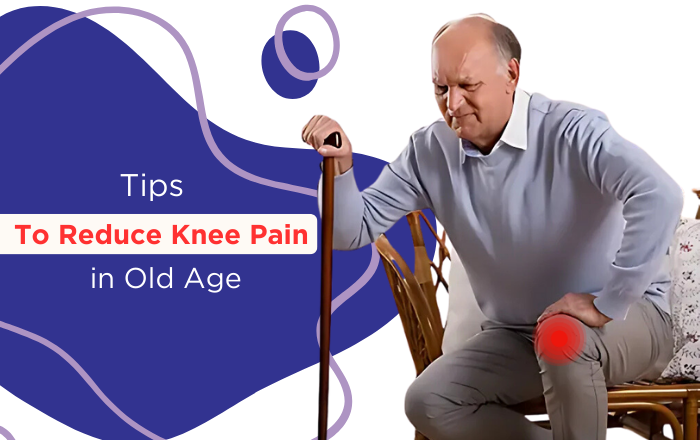Knee pain is one of the most common complaints among older people, significantly affecting their mobility and quality of life. As we age, wear and tear on the joints, injuries and underlying health conditions such as arthritis can cause persistent discomfort. The good news is that there are several effective strategies for reducing knee pain and maintaining joint health in later life. This guide provides practical tips, lifestyle changes and medical evidence to help seniors manage knee pain effectively.
1. Common Causes of Knee Pain in Old Age
Understanding the causes of knee pain is the first step to treating it effectively. Below are the most common factors that contribute to knee pain in older adults:
1. Osteoarthritis: The natural aging process often leads to the degeneration of cartilage, causing stiffness and pain in the joints.
2. Past injuries: Old injuries or surgeries can resurface as pain or inflammation in the knee joint.
3. Overuse and inactivity: Overuse or prolonged inactivity can weaken the muscles around the knee, causing discomfort.
4. Obesity: Carrying extra weight increases pressure on the knees and speeds up cartilage deterioration.
5. Other health conditions: Conditions such as rheumatoid arthritis, gout or bursitis also contribute to knee pain.
2. Signs and Symptoms to Watch For
Recognising the early signs of knee pain can prevent the condition from getting worse. Here are some symptoms to look out for:
- Swelling and stiffness around the knee.
- Difficulty bending, straightening or putting weight on the knee.
- A clicking or grinding noise with movement.
- Persistent pain at rest or during activities such as walking or climbing stairs.
- Redness or warmth, which may indicate inflammation.
If these symptoms persist, you should see a doctor.
3. Importance of Early Diagnosis
Timely diagnosis is crucial in preventing long-term joint damage. Early intervention can:
- Slow the progression of degenerative diseases like osteoarthritis.
- Preserve joint mobility.
- Minimize the need for invasive treatments like surgery.
Doctors often use diagnostic tools such as X-rays, MRIs, or physical exams to determine the underlying causes of knee pain.
4. Lifestyle Changes to Reduce Knee Pain
Making a few lifestyle adjustments can significantly ease knee pain:
A. Maintain a healthy weight
Being overweight puts unnecessary stress on your knee joints. Research shows that losing even a small amount of weight can reduce knee pain in people with osteoarthritis.
B. Stay active
Low-impact activities such as walking, swimming or cycling strengthen the muscles around the knee and improve joint stability. Avoid high-impact activities such as running or jumping, which can increase pain.
C. Use proper footwear
Supportive shoes can reduce stress on your knees by improving posture and weight distribution. Consider orthopaedic footwear for added comfort.
5. Dietary Recommendations for Knee Health
A balanced diet can help manage knee pain and reduce inflammation. Consider incorporating the following foods into your diet:
1. Anti-inflammatory foods: Fatty fish (salmon, mackerel), turmeric, ginger and green tea.
2. Calcium and vitamin D: Dairy, leafy greens and fortified cereals promote bone health.
3. Joint Supplements: Glucosamine, chondroitin and omega-3 fatty acids have been shown to support joint cartilage and reduce stiffness.
Avoid processed foods, sugary drinks and excessive alcohol, which can increase inflammation.
Read More Blogs – Knee Replacement Aftercare: Tips for Patients
6. Exercises and Physical Therapy
A. Strengthening Exercises
Building strength in the quadriceps, hamstrings, and calves can provide additional support to your knees. Some effective exercises include:
Leg lifts
Mini-squats
Wall sits
B. Stretching
Regular stretching improves flexibility and reduces stiffness. Focus on hamstring stretches, calf stretches, and yoga poses that support joint health.
C. Physiotherapy
A trained physiotherapist can design a personalized program to target your specific knee pain issues, ensuring safe and effective progress.
7. Home Remedies for Knee Pain
Home remedies are a convenient way to treat minor knee pain:
- Hot and cold therapy: Alternate between ice packs to reduce swelling and heat packs to relax the muscles.
- Essential oils: Massaging with oils such as eucalyptus or peppermint can help relieve pain.
- Support devices: Use knee braces or compression sleeves for added stability during physical activity.
When to Consult an Orthopedic Doctor
If knee pain persists or worsens despite your efforts, it is important to seek professional help. Dr. Rajeev Gawhale, an orthopedic doctor in Phursungi, specializes in diagnosing and treating knee-related issues. With years of experience, he provides tailored treatment plans to help seniors regain their mobility and lead pain-free lives.
FAQs
1. Are home remedies effective for reducing knee pain?
Home remedies like hot/cold packs and massages can alleviate mild pain but should be combined with professional advice for chronic issues.
2. What are the best exercises for knee pain?
Low-impact exercises such as swimming, walking, and leg-strengthening workouts are ideal.
3. Why should I visit Dr. Rajeev Gawhale for knee pain treatment?
Dr. Gawhale is an experienced orthopedic doctor in Phursungi, offering expert care tailored to individual needs.
Reducing knee pain as you age requires a proactive approach that combines lifestyle changes, dietary improvements and medical care. Whether through home remedies or advanced therapies, managing knee pain can improve your mobility and overall quality of life. For personalized treatment, consider consulting Dr. Rajeev Gawhale, a trusted orthopedic specialist in Phursungi.






